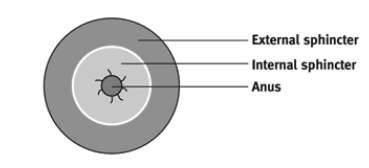Anal sphincter exercises for women
This page has been designed to help you exercise your sphincter muscles. Sphincter exercises can help you to reduce leakage from the bowel. These exercises are also beneficial for patients who are due to have a colostomy or ileostomy (stoma) reversal operation. When done correctly these exercises can build up and strengthen the muscles to help you to hold both wind and stool in the back passage.
Where are these muscles?
The back passage or anus has two rings of muscle around it (see diagram below).
The internal ring of muscle (sphincter) normally stays shut at all times until you actually need to empty your bowels, when it should automatically open.
The external ring of muscle (sphincter) which you can squeeze more tightly when you need to, for example, when you have urgency or diarrhoea.

These muscles can become weak after childbirth, regular episodes of constipation or straining, normal ageing or because of lack of use (while a stoma is in place). If you have weak muscles you may leak wind, liquid or solid stools.

If the muscles are damaged or weak, they may not close immediately or completely after you have been to the toilet. This often makes it difficult to wipe clean, and you may find that you leak for a while after opening your bowels. You may find that you leak during strenuous exercise, lifting heavy weights or when you walk any distance. Some people also find that a small amount of stool is passed with wind.
How can exercises help?
The internal sphincter is most often the problem relating to leakage. This cannot be strengthened by exercise. It is an involuntary muscle, which is outside of our control. It is the external sphincter muscle that you can exercise. The aim is to exercise this muscle enough to make it thicker and stronger, so that it gives more support and may compress the internal muscles to prevent leakage. Speeding up the reaction of this muscle may also help with wind control.
Like any other muscle in the body, the more you use and exercise it, the stronger the sphincter muscle will be, however we recommend sticking to the optimum amount advised below. This will be hard work and often takes several months to be effective.
How to exercise your sphincter muscles?
Sit comfortably with your knees apart. Imagine you are trying to stop passing wind and at the same time try to stop the flow of urine midstream. You should feel a sensation of ‘squeeze and lift’ as you close and draw up the back and front passages. Hold this for as many seconds as you can (up to a maximum of 10 seconds). At the end of the hold there should be a definite feeling of ‘letting go’.
It is easy to use the wrong muscles. Try not to:
- Pull in your tummy, squeeze your legs together, clench your buttocks or hold your breath
You can check that you are doing the exercises properly by gently resting a couple of fingertips on the outside of the back passage. You should only feel a squeeze at your fingertips not in your buttock muscles.
How often and how many?
To strengthen the muscles properly you need to do 24 exercises a day.
To avoid over tiring the muscle only 8 holds should be performed at a time with at least 5 seconds rest in between each hold. Try doing 8 holds, 3 times per day.
Other tips
Use your muscles when you need them – pull up the muscles if you feel that you are about to leak. This can be more effective if you do a more gentle contraction that you can hold for longer until the urge passes.
Try and keep to your correct weight – more weight will put extra strain on these muscles. Please visit the ‘How can I make myself healthier?’ web page, the address is at the end of this page.
Remember, you can do these exercises wherever you are – nobody need know that you are doing them.
How will I know if I am getting better?
Regular sphincter exercises should give the best results within 6 months.
Contact information
If you have any problems doing your exercises or if you do not understand any part of this information, please contact your local Pelvic Health Physiotherapist:
Email: ghn-tr.womenshealthphysio@nhs.net
To see a Physiotherapist, you can self-refer online at www.gloshospitals.nhs.uk/physio
For more information, visit the Gloucestershire Hospitals Physiotherapy webpage:
Further information
How can I make myself healthier?
Website: www.gloshospitals.nhs.uk/physio/health
Expert Self Care Ltd
Please visit your app store and search for the Expert Self Care – CONfidence app for more information about continence and the support available.